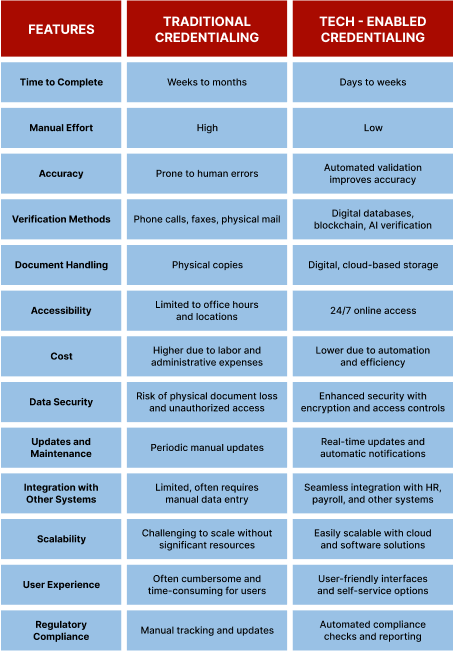Introduction:
The Durable Medical Equipment (DME) industry is on the cusp of a technological revolution, particularly in the realm of credentialing. As we navigate through 2024, two groundbreaking technologies are at the forefront of this transformation: Artificial Intelligence (AI) and blockchain. These innovations promise to streamline processes, enhance security, and fundamentally change how DME providers approach credentialing. In this blog post, we’ll explore the current applications, benefits, challenges, and future potential of AI and blockchain in DME credentialing.
The Technological Revolution in DME Credentialing
The traditional DME credentialing process has long been characterized by time-consuming paperwork, manual verifications, and potential for human error. However, the integration of AI and blockchain is rapidly changing this landscape:
- AI is automating repetitive tasks, improving accuracy, and accelerating the credentialing timeline.
- Blockchain is enhancing data security, improving transparency, and creating immutable records of credentials.
These technologies are not just incremental improvements; they represent a paradigm shift in how the industry approaches credentialing.
Artificial Intelligence in Credentialing: Current Applications
AI is already making significant inroads in DME credentialing. Here are some key applications:
- Document Verification:
- AI-powered Optical Character Recognition (OCR) can quickly scan and extract information from credentials, licenses, and certifications.
- Machine learning algorithms can verify the authenticity of documents by comparing them against known templates and patterns.
- Continuous Monitoring:
- AI systems can continuously monitor regulatory databases, alerting providers to any changes that might affect their credentialing status.
- Predictive analytics can forecast when renewals or updates will be needed, allowing for proactive management of credentials.
- Application Processing:
- Natural Language Processing (NLP) can review and categorize credentialing applications, flagging potential issues for human review.
- AI can automate the routing of applications to appropriate reviewers based on speciality or complexity.
- Data Aggregation and Analysis:
- AI can quickly compile and analyze data from multiple sources, providing a comprehensive view of a provider’s qualifications.
- Machine learning algorithms can identify patterns and trends in credentialing data, potentially uncovering insights for process improvement.
Blockchain Technology: Ensuring Data Integrity and Security
Blockchain technology is bringing unprecedented levels of security and transparency to DME credentialing:
- Immutable Record-Keeping:
- Once recorded on a blockchain, credentialing information cannot be altered without leaving a clear audit trail.
- This immutability reduces the risk of fraud and ensures the integrity of credentialing data.
- Decentralized Verification:
- Blockchain allows for decentralized verification of credentials, potentially reducing the need for repetitive primary source verifications.
- Payers and regulatory bodies can access a single, trusted source of credentialing information.
- Smart Contracts:
- Blockchain-based smart contracts can automate certain aspects of the credentialing process, such as triggering renewals or updates when specific conditions are met.
- Enhanced Data Sharing:
- With appropriate permissions, blockchain can facilitate secure sharing of credentialing information across different healthcare organizations and payers.

Benefits and Challenges of AI and Blockchain Adoption
Benefits:
- Increased Efficiency: Dramatically reduced processing times for credentialing applications.
- Improved Accuracy: Reduction in errors associated with manual data entry and verification.
- Enhanced Security: Better protection against fraud and unauthorized alterations of credentialing data.
- Cost Savings: Long-term reduction in administrative costs associated with credentialing.
- Real-Time Updates: Ability to maintain current, accurate credentialing information at all times.
Challenges:
- Initial Implementation Costs: Significant investment may be required to adopt these technologies.
- Integration with Legacy Systems: Challenges in integrating new technologies with existing credentialing systems.
- Regulatory Compliance: Ensuring that AI and blockchain implementations meet all regulatory requirements.
- Data Privacy Concerns: Addressing concerns about data privacy and control, especially with blockchain’s immutable nature.
- Workforce Adaptation: Need for training and potential resistance to change from staff accustomed to traditional processes.
Real-World Implementations: Pioneers in Tech-Driven Credentialing
While protecting privacy, let’s look at some anonymized examples of organizations pioneering the use of AI and blockchain in credentialing:
Case Study 1: National DME Network
- Implementation: AI-powered credentialing verification system
- Result: Reduced credentialing processing time by 60% and improved accuracy rates to 99.8%
Case Study 2: Midwest Healthcare Consortium
- Implementation: Blockchain-based shared credentialing database
- Result: Eliminated duplicate credentialing efforts across member organizations, saving an estimated $2 million annually
Preparing Your DME Business for the Tech-Enabled Future
As AI and blockchain continue to reshape DME credentialing, here are steps you can take to prepare:
- Stay Informed: Regularly educate yourself and your team about advancements in credentialing technology.
- Assess Your Current Process: Identify areas in your credentialing workflow that could benefit from automation or enhanced security.
- Start Small: Consider piloting AI or blockchain solutions in specific areas of your credentialing process before full-scale implementation.
- Collaborate: Engage with technology providers, industry associations, and peers to share knowledge and best practices.
- Invest in Training: Ensure your staff is prepared for the transition to tech-enabled credentialing processes.
- Plan for Data Migration: Develop a strategy for securely transferring your existing credentialing data to new systems.
Conclusion:
The integration of AI and blockchain into DME credentialing represents a significant leap forward for the industry. These technologies offer the potential to dramatically improve efficiency, accuracy, and security in the credentialing process. While challenges exist, the benefits of adoption are becoming increasingly clear.
As we move further into 2024 and beyond, DME providers who embrace these technological advancements will likely find themselves at a competitive advantage. By streamlining credentialing processes and enhancing data integrity, AI and blockchain can free up resources, allowing providers to focus more on what truly matters: delivering high-quality care to patients.
How WWS Can Help:
At WWS, we’re at the forefront of technological advancements in DME credentialing. Our team of experts can help you:
- Assess your readiness for AI and blockchain integration in your credentialing processes
- Develop a customized strategy for implementing these technologies in your DME business
- Provide training and support to ensure a smooth transition to tech-enabled credentialing
- Stay compliant with evolving regulations surrounding the use of AI and blockchain in healthcare
- Maximize the benefits of these technologies to streamline your operations and enhance your competitive edge
Let WWS be your guide in navigating the exciting future of DME credentialing. Our expertise can help you harness the power of AI and blockchain to transform your credentialing processes and drive your business forward.
CTA:
Ready to explore how AI and blockchain can revolutionize your DME credentialing process? Schedule an introductory meeting with our technology experts today! Click here to book your Collaborative Discovery Meeting: https://calendly.com/wwshcs/wws-collaborative-discovery-meeting




